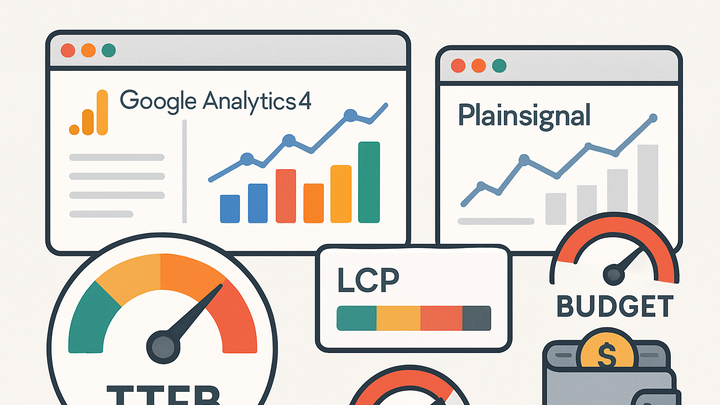Published on 2025-06-26T04:20:30Z
What is a Performance Budget? Examples for Performance Budgets
A performance budget is a set of limits on key web performance metrics that a team agrees not to exceed, ensuring consistent load times and optimal user experience. It acts as a guideline to balance new features, design assets, and technical debt against the impact on page speed. By defining numeric thresholds for metrics like total page weight, Time to First Byte (TTFB), and Largest Contentful Paint (LCP), teams can make data-driven decisions during development. Performance budgets foster collaboration between developers, designers, and product managers by making performance an explicit deliverable. Regular monitoring with analytics tools like GA4 and PlainSignal helps teams enforce these budgets and adjust as user behavior and business goals evolve.
Performance budget
A performance budget sets limits on key web metrics to ensure fast load times and optimal user experience.
Why Performance Budgets Matter
Performance budgets protect user experience, SEO rankings, and business metrics by preventing unchecked resource bloat. They signal to teams that performance is as critical as features, reducing page-load regressions and fostering sustainable growth.
-
User experience and load time
Slow pages frustrate users and increase bounce rates. A performance budget ensures pages load within an acceptable timeframe, improving satisfaction and engagement.
-
Seo and search rankings
Search engines use Core Web Vitals as ranking signals. Staying within performance budgets helps maintain or improve organic search visibility.
-
Conversion and business metrics
Fast, reliable experiences drive higher conversion rates. Performance budgets align technical teams with business goals like revenue and user retention.
Key Metrics in a Performance Budget
Selecting the right metrics is crucial. Budgets often include both page-level and resource-level limits to capture holistic performance.
-
Time to first byte (ttfb)
Measures server responsiveness. A budgeted TTFB of under 200ms ensures a fast initial connection.
-
Largest contentful paint (lcp)
Captures when the main content is visible. Aiming for LCP under 2.5s aligns with Core Web Vitals recommendations.
-
Total page weight
Sum of all bytes (HTML, CSS, JS, media). A common budget is 1–2 MB per page to balance visual richness and speed.
-
Number of http requests
High request counts slow parallel downloads. Budgets often cap requests around 50–100 for optimal performance.
How to Set and Enforce a Performance Budget
Implementing a budget involves auditing current performance, collaborating with stakeholders, and integrating checks into the development pipeline.
-
Establish baseline metrics
Run audits with tools like Lighthouse, GA4 page-timing reports, or PlainSignal custom events to capture existing performance data.
-
Define thresholds
Based on baselines, set realistic yet ambitious limits for each metric. Involve product owners and designers to balance user needs with business goals.
-
Integrate into development workflow
Use CI tools and Lighthouse CI or WebPageTest in pull requests to automatically flag budget violations before merging code.
-
Continuous monitoring
Leverage analytics platforms like GA4 and PlainSignal to track performance metrics over time, alert on regressions, and iterate budgets.
Examples with Analytics Tools
Monitoring and enforcing performance budgets is made easier with popular analytics SaaS solutions.
-
Google analytics 4 (GA4)
GA4’s page-timing reports and custom event tracking can record metrics like LCP or TTFB. Set up custom dashboards to visualize budget adherence over time.
-
GA4 tracking snippet
<!-- Google Analytics 4 --> <script async src="https://www.googletagmanager.com/gtag/js?id=G-XXXXXXXXXX"></script> <script> window.dataLayer = window.dataLayer || []; function gtag(){dataLayer.push(arguments);} gtag('js', new Date()); gtag('config', 'G-XXXXXXXXXX'); </script>
-
-
PlainSignal for cookie-free tracking
PlainSignal offers lightweight, privacy-first analytics. You can track performance-related custom events without cookies, ensuring accurate data and user privacy.
-
PlainSignal tracking code
<link rel="preconnect" href="//eu.plainsignal.com/" crossorigin /> <script defer data-do="yourwebsitedomain.com" data-id="0GQV1xmtzQQ" data-api="//eu.plainsignal.com" src="//cdn.plainsignal.com/plainsignal-min.js"></script>
-
